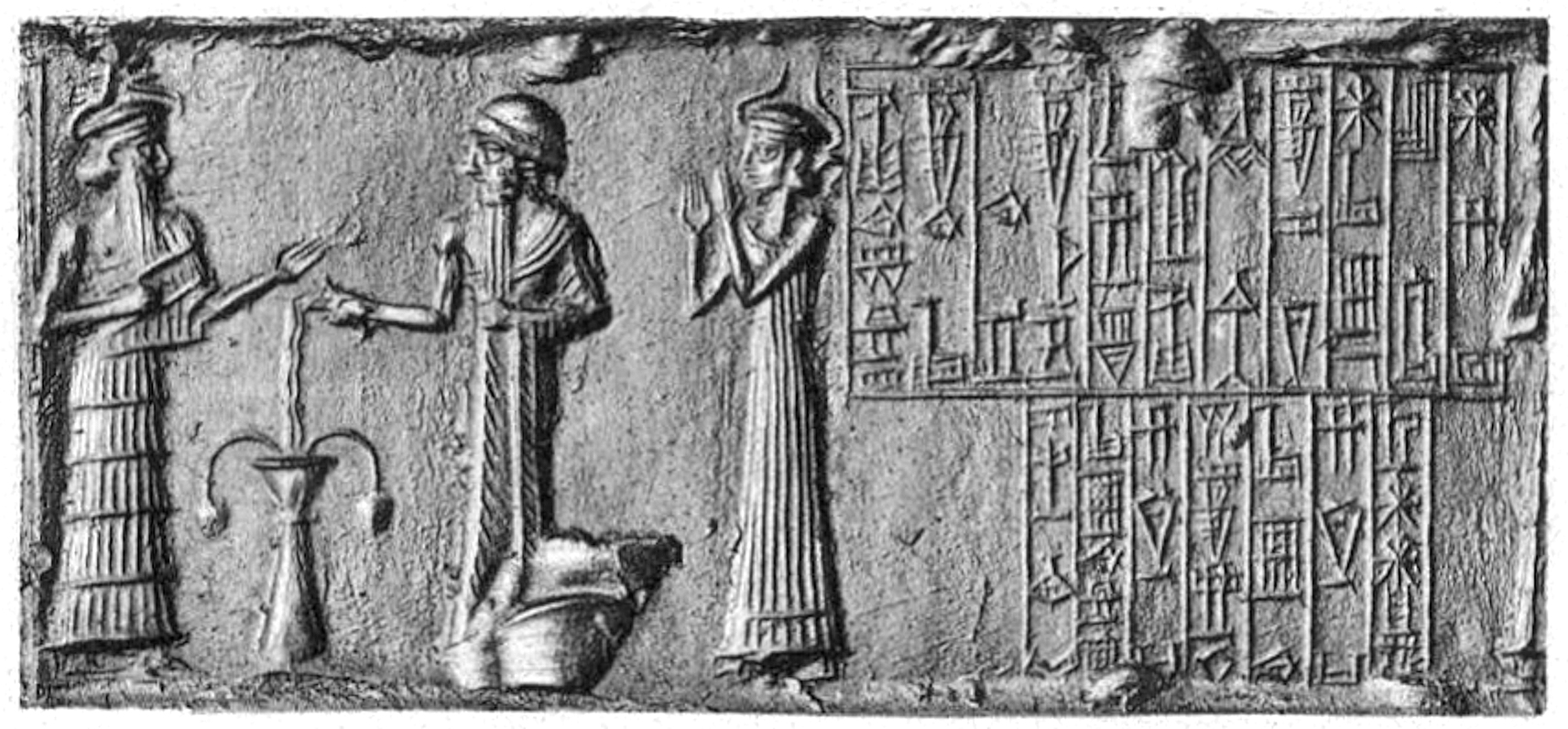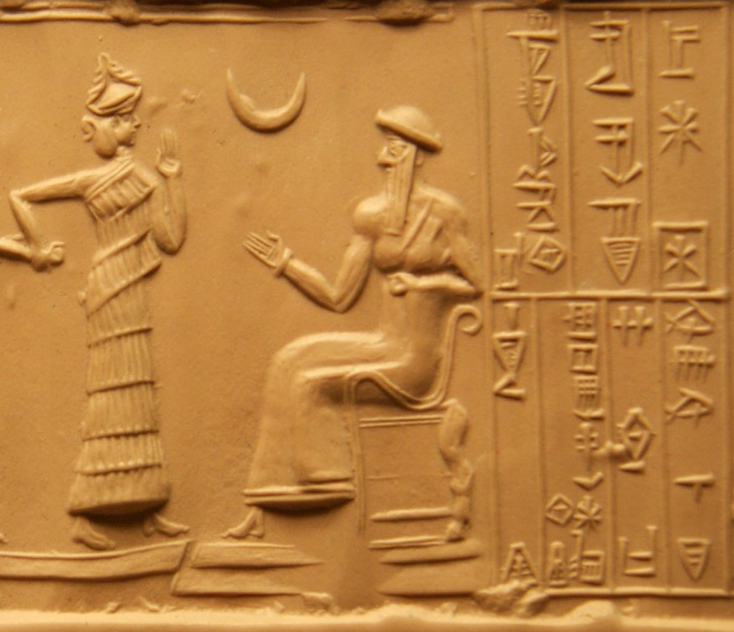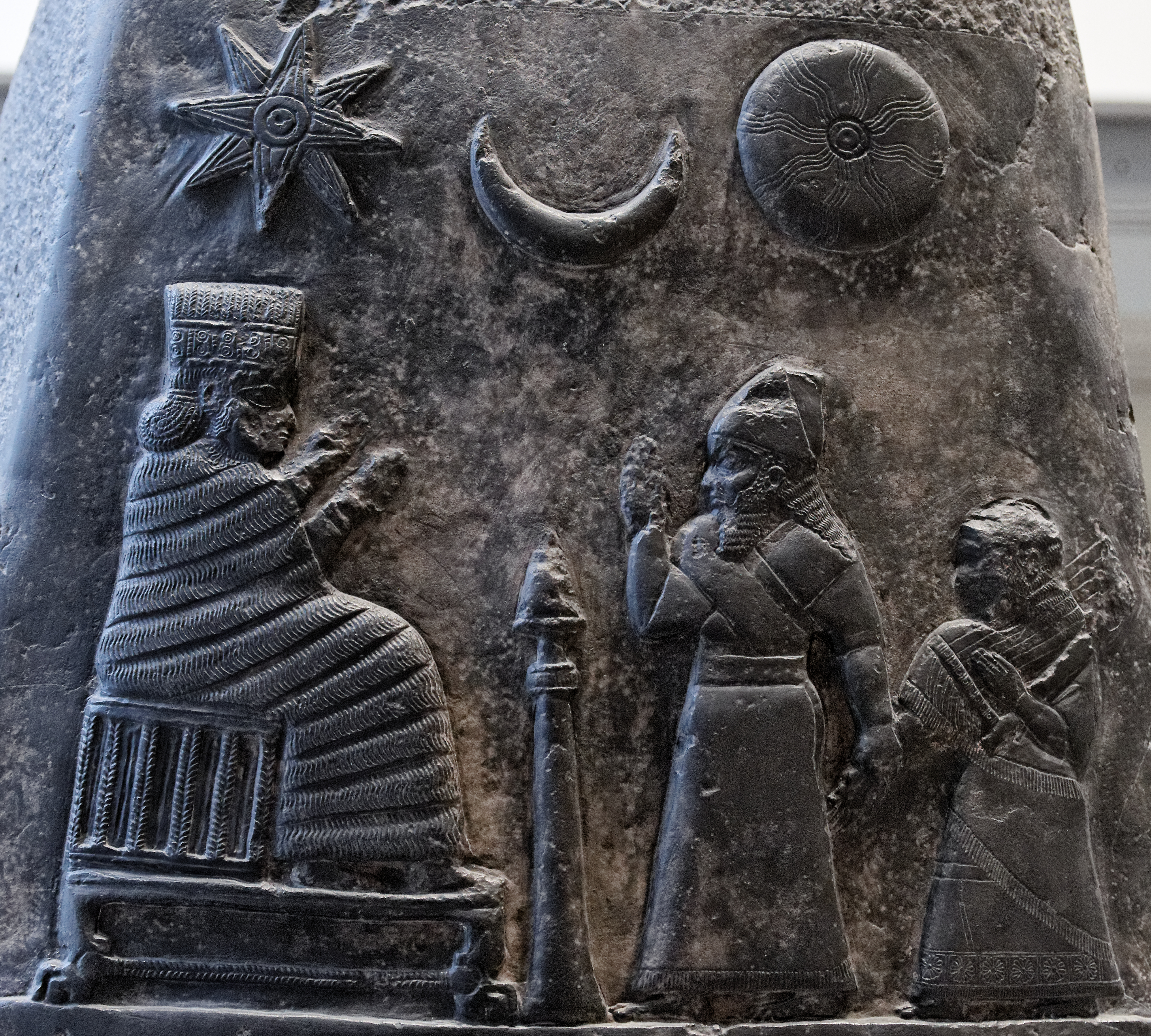|
Amar-Sin
Amar-Sin (: '' DAmar D Sîn'', "calf of Sîn", the "𒀭" being a silent honorific for "Divine"),(died c. 2037 BC) initially misread as Bur-Sin (c. 2046–2037 BC) middle chronology, was the third ruler of the Ur III Dynasty. He succeeded his father Shulgi (c. 2030–1982 BC). His name translates to 'bull calf of the moon-god'. The name Amar-Sin was not recorded before his ascension and is a " throne name". His original name, and whether he was actually the son of Shulgi, is unknown. It has been proposed that Amar-Sin, Shu-Sin, and Ibbi-Sin were all brothers and sons of Shulgi. Alternatively it has been suggested that Amar-Sin was a nephew of Shulgi, explaining his difficulties at the beginning and ending of his reign. Reign Year-names are known for all nine years of his reign. These record campaigns conducted against Urbilum, and several other regions with obscure names: Shashrum, Shurudhum, Bitum-Rabium, Jabru, and Huhnuri. Amar-Sin is otherwise known to have campaigned agains ... [...More Info...] [...Related Items...] OR: [Wikipedia] [Google] [Baidu] |
Eridu
Eridu (; Sumerian: eridugki; Akkadian: ''irîtu'') was a Sumerian city located at Tell Abu Shahrain (), also Abu Shahrein or Tell Abu Shahrayn, an archaeological site in Lower Mesopotamia. It is located in Dhi Qar Governorate, Iraq, near the modern city of Basra. Eridu is traditionally considered the earliest city in southern Mesopotamia based on the Sumerian King List. Located 24 kilometers south-southwest of the ancient site of Ur, Eridu was the southernmost of a conglomeration of Sumerian cities that grew around temples, almost in sight of one another. The city gods of Eridu were Enki and his consort Damkina. Enki, later known as Ea, was considered to have founded the city. His temple was called E-Abzu, as Enki was believed to live in Abzu, an aquifer from which all life was thought to stem. According to Sumerian temple hymns, another name for the temple of Ea/Enki was called Esira (Esirra). At nearby Ur there was a temple of Ishtar of Eridu (built by Lagash's ruler Ur- ... [...More Info...] [...Related Items...] OR: [Wikipedia] [Google] [Baidu] |
Shulgi
Shulgi ( dšul-gi,(died c. 2046 BC) formerly read as Dungi) of Ur was the second king of the Third Dynasty of Ur. He reigned for 48 years, from (Middle Chronology). His accomplishments include the completion of construction of the Great Ziggurat of Ur, begun by his father Ur-Nammu. On his inscriptions, he took the titles "King of Ur", " King of Sumer and Akkad", adding " King of the four corners of the universe" in the second half of his reign. He used the symbol for divinity ( ) before his name, marking his apotheosis, from at least the 21st year of his reign and was worshipped in the Ekhursag palace he built. Shulgi was the son of Ur-Nammu king of Ur and his queen consort Watartum. Life and reign Shulgi apparently led a major modernization of the Third Dynasty of Ur. He improved communications, reorganized the army, reformed the writing system and weight and measures, unified the tax system, and created a strong bureaucracy. He also wrote a law code, now known as the ... [...More Info...] [...Related Items...] OR: [Wikipedia] [Google] [Baidu] |
Neo-Sumerian Empire
The Third Dynasty of Ur or Ur III was a Sumerian dynasty based in the city of Ur in the 22nd and 21st centuries BC (middle chronology). For a short period they were the preeminent power in Mesopotamia and their realm is sometimes referred to by historians as the Neo-Sumerian Empire. The Third Dynasty of Ur is commonly abbreviated as "Ur III" by historians studying the period. It is numbered in reference to previous dynasties, such as the First Dynasty of Ur (26-25th century BC), but it seems the once supposed Second Dynasty of Ur was never recorded. The Third Dynasty of Ur was the last Sumerian dynasty which came to preeminent power in Mesopotamia. It began after several centuries of control, exerted first by the Akkadian Empire, and then, after its fall, by Gutian and independent Sumerian city-state kings. It controlled the cities of Isin, Larsa, and Eshnunna and extended as far north as Upper Mesopotamia. The Ur III provinces, from north to south were Sippar, Tiwe, Urum, Pu� ... [...More Info...] [...Related Items...] OR: [Wikipedia] [Google] [Baidu] |
Third Dynasty Of Ur
The Third Dynasty of Ur or Ur III was a Sumerian dynasty based in the city of Ur in the 22nd and 21st centuries BC ( middle chronology). For a short period they were the preeminent power in Mesopotamia and their realm is sometimes referred to by historians as the Neo-Sumerian Empire. The Third Dynasty of Ur is commonly abbreviated as "Ur III" by historians studying the period. It is numbered in reference to previous dynasties, such as the First Dynasty of Ur (26-25th century BC), but it seems the once supposed Second Dynasty of Ur was never recorded. The Third Dynasty of Ur was the last Sumerian dynasty which came to preeminent power in Mesopotamia. It began after several centuries of control, exerted first by the Akkadian Empire, and then, after its fall, by Gutian and independent Sumerian city-state kings. It controlled the cities of Isin, Larsa, and Eshnunna and extended as far north as Upper Mesopotamia. The Ur III provinces, from north to south were Sippar, Tiwe, Urum, ... [...More Info...] [...Related Items...] OR: [Wikipedia] [Google] [Baidu] |
Hamazi
Hamazi or Khamazi ( Sumerian: , ''ha-ma-zi''ki, or ''Ḫa-ma-zi2''ki) was an ancient kingdom or city-state which became prominent during the Early Dynastic period. Its exact location is unknown. History In the early days of archaeology two pottery fragments were found in Nippur which it was assumed were part of the same vessel (CBS 9571+CBS 9577). One referred to a Uhub/Utug ruler of Kish and the other to an unknown ruler defeating Hamazi. Subsequent analysis showed that the two fragments did not in fact belong to the same vessel. The relevant fragment (BM 129402) reads " o the deity DN Pssussu, vanquisher of Hamazi, dedi ated(this vessel).".Douglas Frayne, "Unattributed", in Presargonic Period: Early Periods, Volume 1 (2700-2350 BC), Toronto: University of Toronto Press, pp. 441-444, 2008 One of the earliest references to Hamazi is found in the epic literary composition ''Enmerkar and the Lord of Aratta'', where Enmerkar prays to Enki about the confusion of languages in the ... [...More Info...] [...Related Items...] OR: [Wikipedia] [Google] [Baidu] |
Shu-Sin
Shu-Sin, also Šu-Suen (: '' DŠu D Sîn'', after the Moon God Sîn", the "𒀭" being a silent honorific for "Divine", formerly read Gimil-Sin) (died c. 2028 BC) was king of Sumer and Akkad, and was the fourth king of the Ur III dynasty. He succeeded his father Amar-Sin, and reigned 2037–2028 BC (Middle Chronology). Reign Following an open revolt of his Amorite subjects, he directed the construction of a fortified wall between the Euphrates and the Tigris rivers in his fourth year, intending it to hold off any further Amorite attacks. He was succeeded by his son Ibbi-Sin. An erotic poem addressed to Shu-Sin by a female speaker is preserved in a cuneiform tablet called Istanbul 2461. The poem's speaker expresses her strong desires and longings for the king. An inscription states that he gave his daughter in marriage to the ruler of Šimānum "His daughter was given as a bride to Simanum. Simanum, Habura, and the surrounding districts rebelled against the king, they chased ... [...More Info...] [...Related Items...] OR: [Wikipedia] [Google] [Baidu] |
Correspondence Of The Kings Of Ur
The ''Correspondence of the Kings of Ur'' (CKU), also known as the ''Royal Correspondence of Ur'', is a collection of 24 literary letters written in the Sumerian language and attributed to kings of the Ur III period, 2048–1940 BCE (2112–2004 middle chronology). They are known primarily from copies dating to the Old Babylonian period, ca. 1800–1600 BCE; their original date of composition and their historical accuracy are debated. Copies of the letters The CKU letters are known only through copies written on clay tablets as school exercises by students learning to write cuneiform. All but one of the known copies have been dated to the Old Babylonian period, and were found in cities of Mesopotamia or the broader Near East, including Nippur, Ur, Isin, Uruk, Kish, Sippar, and Susa Susa ( ) was an ancient city in the lower Zagros Mountains about east of the Tigris, between the Karkheh River, Karkheh and Dez River, Dez Rivers in Iran. One of the most important cities of t ... [...More Info...] [...Related Items...] OR: [Wikipedia] [Google] [Baidu] |
Marhashi
Marhaši (Sumerian language, Sumerian: ''Mar-ḫa-šiKi (cuneiform), Ki'' , ''Marhashi'', ''Marhasi'', ''Parhasi'', ''Barhasi''; in earlier sources Waraḫše) was an important ancient Near East polity situated in the region near Elam. It is generally assumed, though not certain, that the Paraḫšum/Baraḫšum ( ''pa2-ra-ah-shum2-ki'') of the Akkadian Empire period referred to Marhaši. This equivalence has been challenged. It is known from 3rd millennium BC and early 2nd millennium BC Mesopotamian sources. Its precise location has not been identified but the current thinking places it on the eastern side of the Iranian plateau. The language of Marhaši is considered to be different from that of Simaški, and only minimally Elamite-related. Marhaši is known to have been the source of a number exotic trade goods for Mesopotamia including the "bear of Marhaši". Other trade goods were lapis lazuli and carnelian. One lexical list includes a mention of "Carnelian which is speckl ... [...More Info...] [...Related Items...] OR: [Wikipedia] [Google] [Baidu] |
Zariqum
Zariqum or Zarriqum was a Sumerian governor (''šakkanakkum'') of the city of Assur under the Third Dynasty of Ur, attested there between the 44th year of Shulgi () and the 5th year of Amar-Sin (). He is the only governor of the city during this time, otherwise poorly known from surviving sources, to be known by name. Though he has also been suggested to have been an independent ruler, this is a minority view, as Assur is not generally regarded to have been independent before the time of Puzur-Ashur I, . Under the Sumerian Ur III empire, Assur is generally believed to have formed the northernmost peripheral province. In the ruins of one of the city's temples, dedicated to the goddess Ishtar, an inscription by Zariqum states that he founded a new temple in the city, dedicated to the goddess Bēlat-ekallim (i.e. Ninegal), for the life of Amar-Sin, king of Ur. Zariqum was previously believed to have had a long and wide-spanning career, also having been a military officer and a g ... [...More Info...] [...Related Items...] OR: [Wikipedia] [Google] [Baidu] |
Sin (mythology)
Sin () or Suen (, ) also known as Nanna ( ) is the Mesopotamian god representing the moon. While these two names originate in two different languages, respectively Akkadian language, Akkadian and Sumerian language, Sumerian, they were already used interchangeably to refer to one deity in the Early Dynastic Period (Mesopotamia), Early Dynastic period. They were sometimes combined into the double name Nanna-Suen. A third well attested name is Dilimbabbar (). Additionally, the name of the moon god could be represented by logograms reflecting his lunar character, such as d30 (), referring to days in the lunar month or dU4.SAKAR (), derived from a term referring to the crescent. In addition to his astral role, Sin was also closely associated with cattle herding. Furthermore, there is some evidence that he could serve as a judge of the dead in the Ancient Mesopotamian underworld, underworld. A distinct tradition in which he was regarded either as a god of equal status as the usual hea ... [...More Info...] [...Related Items...] OR: [Wikipedia] [Google] [Baidu] |
Sumerian Kings
The history of Mesopotamia extends from the Lower Paleolithic period until the establishment of the Caliphate in the late 7th century AD, after which the region came to be known as Iraq. This list covers dynasties and monarchs of Mesopotamia up until the fall of the Neo-Babylonian Empire in 539 BC, after which native Mesopotamian monarchs never again ruled the region. The earliest records of writing are known from the Uruk period (or "Protoliterate period") in the 4th millennium BC, with documentation of actual historical events, and the ancient history of the region, being known from the middle of the third millennium BC onwards, alongside cuneiform records written by early kings. This period, known as the Early Dynastic Period, is typically subdivided into three: 2900–2750 BC (ED I), 2750–2600 BC (ED II) and 2600–2350 BC (ED III), and was followed by Akkadian (~2350–2100 BC) and Neo-Sumerian (2112–2004 BC) periods, after which Mesopotamia was most often divided betwee ... [...More Info...] [...Related Items...] OR: [Wikipedia] [Google] [Baidu] |
Mashkan-shapir
Mashkan-shapir (Maškan-šāpir) (modern Tell Abu Duwari, Al Qadisyah Governorate, Iraq) was an ancient '' tell'' roughly north of Nippur and around southeast of Baghdad. The city god of Mashkan-shapir was Nergal and a temple named Meslam dedicated to him was built there. It is about 20 kilometers south of ancient Malgium. The remnants of a large watercourse, thought to be an ancient bed of the Tigris or Euphrates, pass close to the city. History Chalcolithic Though occupied during the Ubaid period (based on clay sickle fragments) and Uruk period (based on pottery fragments). Early Bronze Age Akkadian period The town's first epigraphic appearance was during the Akkadian period in a in reference to an escaped slave. Ur III period It was known during the Ur III period as a location for royal shepherds. A brick of Amar-Sin was also found at the site. Middle Bronze Age Larsa period Mashkan-shapir achieved prominence during the Old Babylonian period. This time of occupation is ... [...More Info...] [...Related Items...] OR: [Wikipedia] [Google] [Baidu] |




